Thomas Burberry founded the luxury British fashion house in 1856, initially creating outdoors attire with unique materials like gabardine, which was hard wearing and waterproof. Burberry famously outfitted the first expedition to reach the South Pole led by Roald Amundsen. Deriving from the needs of trench warfare in World War I, Burberry created arguably its most iconic piece, the trench coat. Lined with the Burberry check, the trench coat was worn by officers in the trenches, and after the war became very popular with the general public. Burberry remained a privately held family company until parent company Great Universal Stores assumed ownership in 1955.
Burberry began to take a foothold in mainstream pop culture in the 1970s as celebrities and stars began sporting the clothing. As the brand grew, Burberry signed licensing deals with global manufacturers, whilst also enforcing high quality standards from their London headquarters. This helped bring Burberry’s reputation of quality into the modern era. In 2001, Burberry became a publicly traded company after a successful IPO. In the early 2000s, Burberry became associated with football hooliganism and ‘chav’ culture. This downturn in its association was widely attributed to its lower prices and a proliferation of counterfeit goods using the trademarked Burberry check design. This negative association would pass, and Burberry achieved mass market success in the following years through licensing deals. To revitalise the brand, in 2006 a design overhaul, massively reducing the use of the Burberry check was implemented to try and break away from its previous negative associations. In recent years Burberry has undergone a rebranding of its logo and monogram and has made commitments to reduce emissions by 46% by 2030 and climate positive by 2040.
Rare Must-See 90s Burberrys TV Advert
How to tell if Burberry is vintage from the logo
1901 to 1968 Burberry logo
- The first Burberry logo debuted, created the foundation for the rest of its logos through the 20th century.
- The Burberry text is capitalised in a thick, bold text.
- The Burberry Equestrian Knight is set above it.
- A dark red is used for the logo.
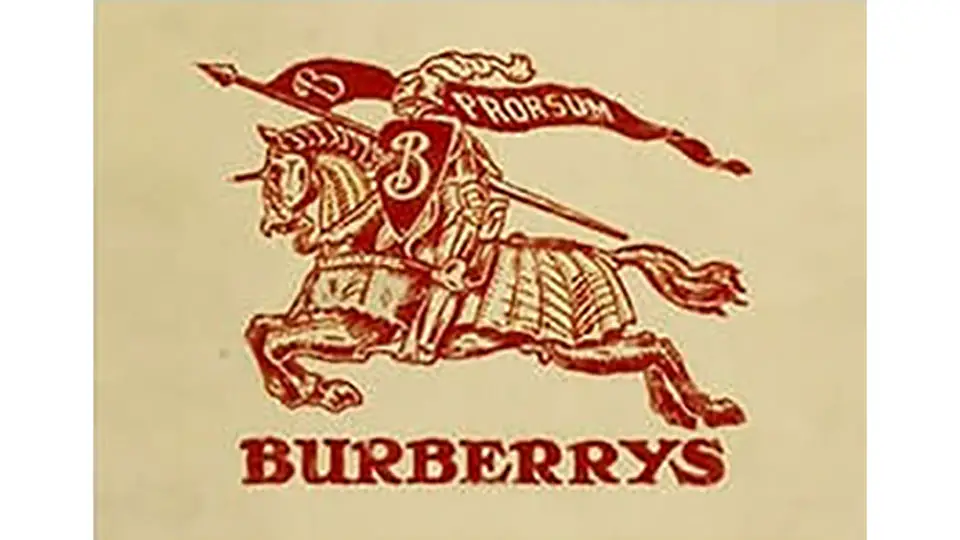
1901 to 1968 Burberry logo
1968 to 1999 Burberry logo
- The next Burberry logo had a similar structure of text with the emblem set above.
- Only the B is capitalised in this logo, with the inclusion of ‘of London’ below, in a thinner version of the same font, all capitalised.
- The Equestrian Knight emblem became a silhouette, using much less detail than its predecessor.
- The logo was changed to all black at this time.

1968 to 1999 Burberry logo
1999 to 2018 Burberry logo
- The structure of the logo did not change in this iteration either.
- However, all the text is capitalised in a thinner font, and interestingly the ‘of’ from ‘of London’ has been dropped, which is why if you have a Burberry piece that says Burberrys of London instead of just Burberry London, there is a good chance that it predates 1999 and that the piece is vintage.
- The emblem combined features from both its previous designs, mostly remaining as a silhouette with some added details.
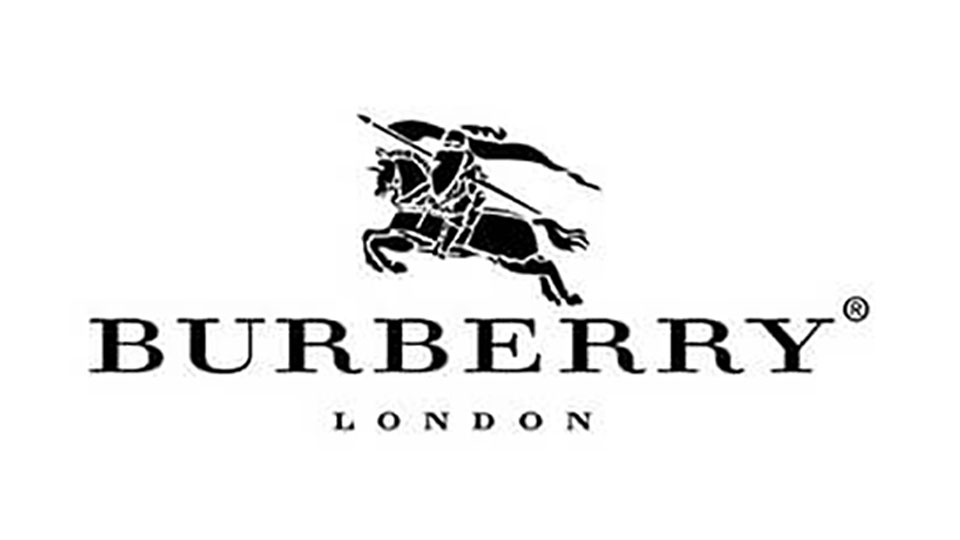
1999 to 2018 Burberry logo
2018 to now
- The most significant change to the logo is its most recent, completely changing the structure and aesthetic.
- The logo is a simple text logo, using blocky, evenly spaced text, with no emblem.
- The removal of the Equestrian Knight has only happened on the logo however, and is still used in a lot of marketing materials and tags.
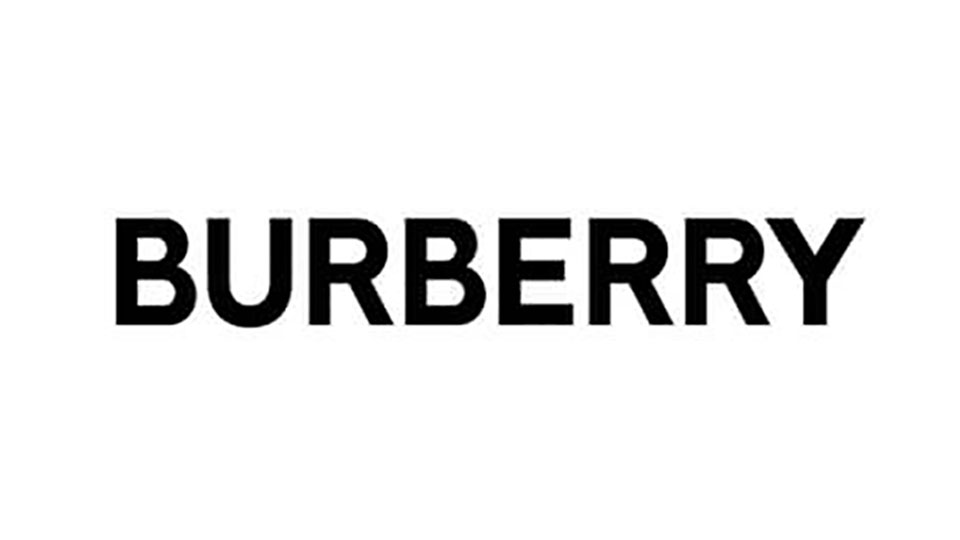
2010s to now Burberry logo
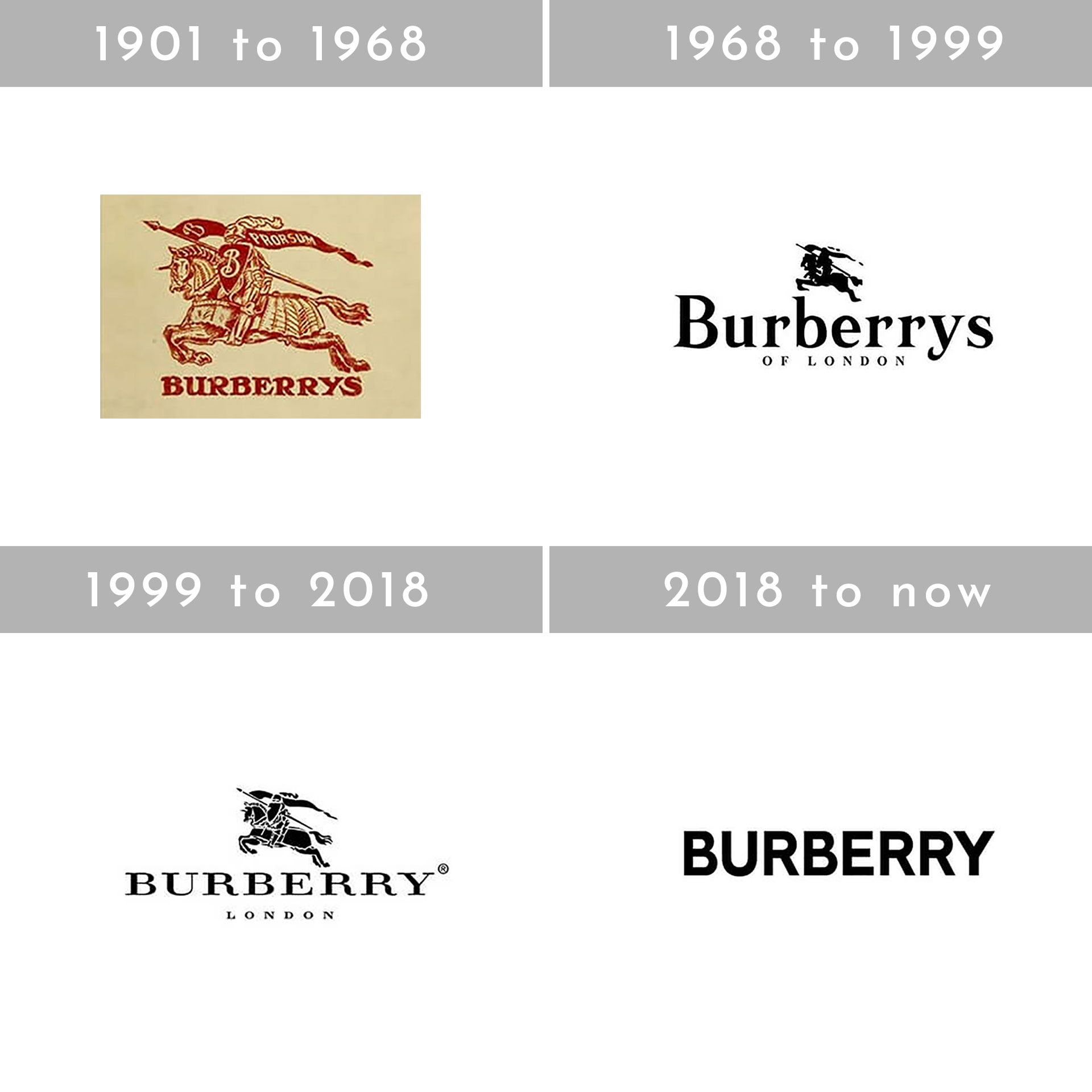
Burberry logo evolution through the years
How to tell if Burberry is vintage from the tags
When identifying whether a Burberry item is vintage based on its tags, several key factors can provide clues about its era of origin. Early Burberry items were typically manufactured in the UK, reflecting the brand’s British heritage, but over time, manufacturing expanded globally, which can help date the item.
Tags themselves evolved over the years. Before the late 1990s, tags were often single fabric pieces with minimal care instructions. From the late 1990s onwards, larger, shiny polyester tags with detailed care instructions in multiple languages became standard. Additionally, older tags typically had information such as sizing and brand names/logos stitched on, which appeared slightly pixelated, whereas modern tags often have this information printed.
The sizing and fit of Burberry clothing also changed over time. Items from the late 80s to early 00s tended to have a larger, less tailored fit, while slim fit clothing became more common from the mid-00s onwards, reflecting a more modern, tailored aesthetic.
Website addresses on tags are another indicator, as these began appearing from the 2000s onwards, marking the item as more modern. Lastly, the language variation on wash tags can be telling: older tags from the 80s and 90s more commonly had instructions in a single language, whereas tags from the 00s onwards typically feature information in multiple languages on much larger polyester tags. By examining these details, you can better determine the likely period an item was made, helping to identify vintage Burberry pieces.
If your tags are missing, visit our vintage clothing identification page. We’re experts at identifying vintage labels for you!
1930s vintage Burberry tags
- Tags from the 1930s are very rarely seen and used the old logo.
- These tags were a large rectangle of fabric completely sewn in.
- No other information other than the brand was included on the tags at this time.

1940s vintage Burberry tags
- A more consistent colour scheme began to be used at this time, with gold font laid over a navy background.
- Other than the brand, no information is included on the tags.

1960s vintage Burberry tags
- Logo changes were reflected in these tags, with an updated font used, however the old emblem was kept.
- The navy background was kept, however the font on the tags was updated to be white.
- The tags became a longer more rectangular shape.
- This created more space to add more information to the tags.
- Examples of this include the country of manufacture and the product line.

1970s vintage Burberry tags
- Whilst the only example of a 1970s tag we have been able to locate has a white background, this was not exclusively the case for tags from this decade, as many of them still used the white font on navy background.
- One notable change across the tags was a reduction of the information such as the product line on the tags, although the country of manufacture was maintained.

1980s vintage Burberry tags
- As Burberry began becoming a global fashion house venturing into new product lines, their tags underwent a significant change for some of their items.
- Many of the tags on core Burberry products such as overcoats remained the same as can be seen.
- Some of the tags began referencing global fashion capitals such as New York and Paris, symbolising its international growth at this time.
- The creation of a wider array of products such as shirts, blouses and jumpers required different types of tags, often in landscape including just the Burberrys name and a reference to London.


1990s vintage Burberry tags
- Burberry tags became thinner and smaller.
- Some of the tags would include measurements on them.
- More often they would include information about the materials used to create the item.
- The silhouette of the emblem was also updated on tags to a more simplified version.
- This is the last era of tags using the ‘Burberrys of London’ branding.


1990s Burberry tags
2000s vintage Burberry tags
- The 2000s saw the rebranding to ‘Burberry London’.
- This was reflected in the tags, which often started including sizing information.
- Materials used and country of manufacture information was moved to the was tags.
- Burberry Brit was also launched with very distinct tags that break away from the mainstream Burberry branding.

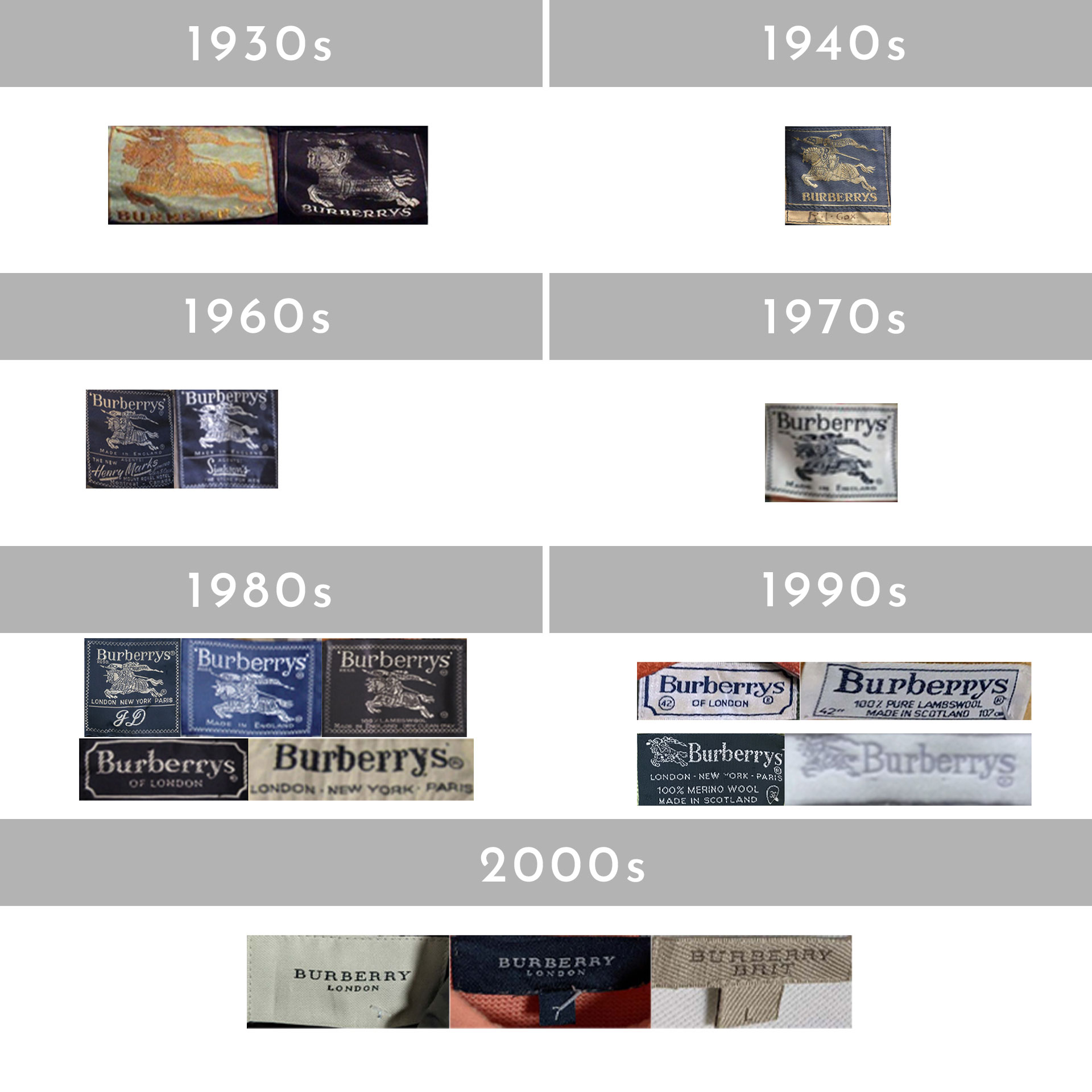
Vintage Burberry tags and labels through the years
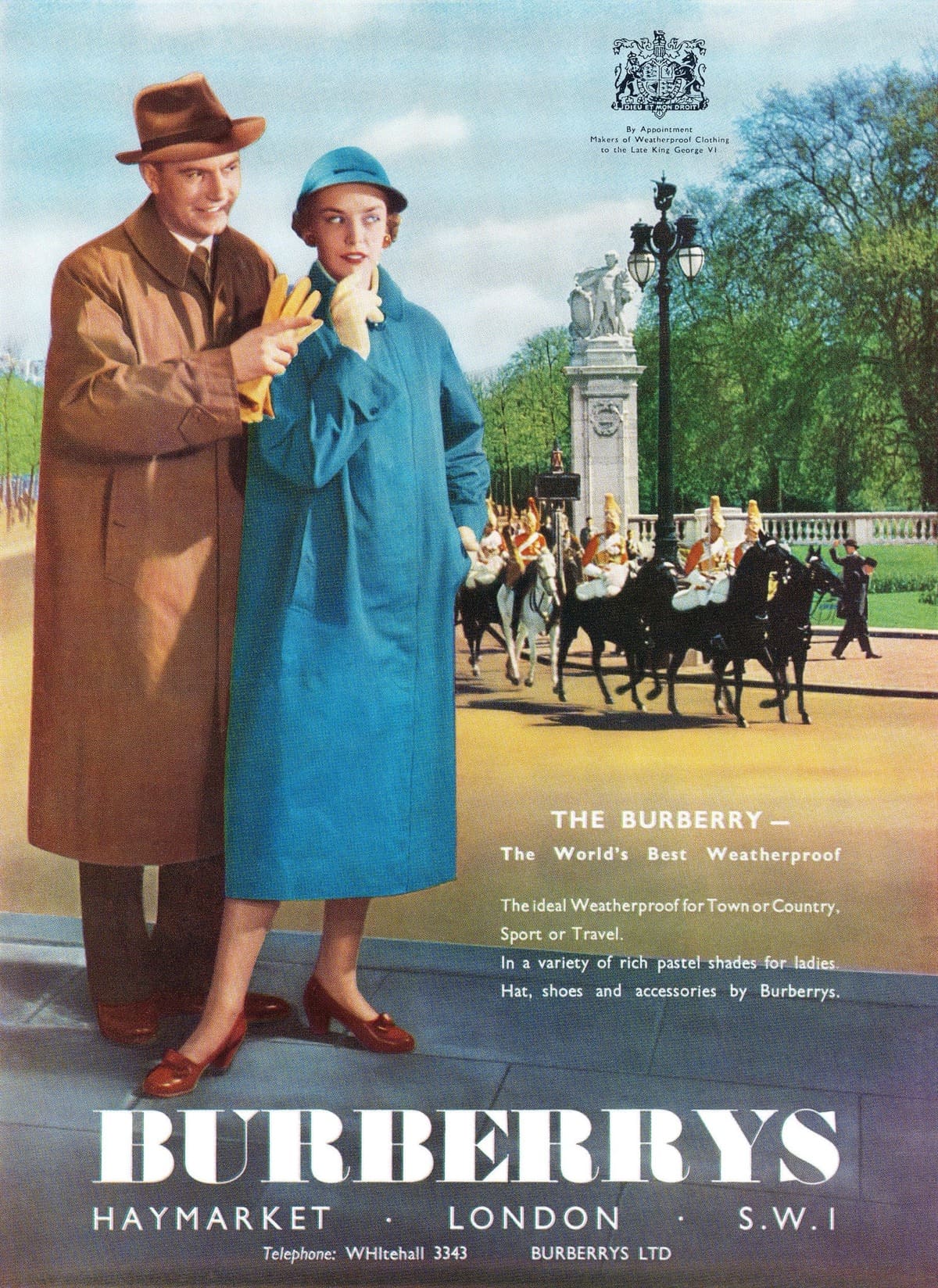




?????? ????? ?????????? ? ???????? ? ???? ??? ??????? ????????? ????? ?????????.
?????????????? ??????????? ??????????? ??? ??????? ????????? ??????? ? ???????? .
???????? ?????????? ?????? ??? ?????????? ????? ?????????????????? ???? ? ????????? ???????? .
???? ???? ??? ??????
??????? ????????????? ? ??????????? GDPR, ??????????? ????????????? ??????????.
???????? ???????????????? ??????? ? ??????????????? ??????? ? ????????? ?????????? .
?????????? ????????? ????????? ??? digital-????????????? — ???????? ?????????????!
Online platforms offer a innovative approach to meet people globally, combining user-friendly features like profile galleries and interest-based filters .
Core functionalities include secure messaging , social media integration, and personalized profiles to enhance interactions .
Smart matching systems analyze preferences to suggest potential partners , while privacy settings ensure trustworthiness.
https://iturdu.net/dating/understanding-the-dynamics-behind-the-cuckold-fantasy/
Many platforms offer premium subscriptions with exclusive benefits , such as unlimited swipes , alongside real-time notifications .
Whether seeking long-term relationships, these sites cater to diverse needs , leveraging AI-driven recommendations to optimize success rates .